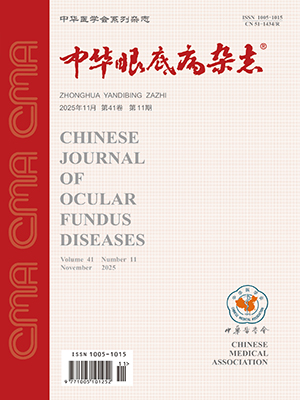| 1. |
Sato T, Tsuboi K, Nakashima H, et al. Characteristics of cases with postoperative vitreous hemorrhage after 25-gauge vitrectomy for repair of proliferative diabetic retinopathy[J]. Graefe's Arch Clin Exp Ophthalmol, 2017, 255(4): 665-671. DOI: 10.1007/s00417-016-3522-8.
|
| 2. |
Khuthaila MK, Hsu J, Chiang A, et al. Postoperative vitreous hemorrhage after diabetic 23-gauge pars plana vitrectomy[J]. Am J Ophthalmol, 2013, 155(4): 757-763. DOI: 10.1016/j.ajo.2012.11.004.
|
| 3. |
Schmidt-Erfurth U, Garcia-Arumi J, Gerendas BS, et al. Guidelines for the management of retinal vein occlusion by the European Society of Retina Specialists (EURETINA)[J]. Ophthalmologica, 2019, 242(3): 123-162. DOI: 10.1159/000502041.
|
| 4. |
Liang XL, Chen HY, Huang YS, et al. Pars plana vitrectomy and internal limiting membrane peeling for macular oedema secondary to retinal vein occlusion: a pilot study[J]. Ann Acad Med Singap, 2007, 36(4): 293-297.
|
| 5. |
Raszewska-Steglinska M, Gozdek P, Cisiecki S, et al. Pars plana vitrectomy with ILM peeling for macular edema secondary to retinal vein occlusion[J]. Eur J Ophthalmol, 2009, 19(6): 1055-1062. DOI: 10.1177/112067210901900625.
|
| 6. |
Yokota R, Inoue M, Itoh Y, et al. Comparison of microinsicion vitrectomy and conventional 20-gauge vitrectomy for severe proliferative diabetic retinopathy[J]. Jpn J Ophthalmol, 2015, 59(5): 288-294. DOI: 10.1007/s10384-015-0396-y.
|
| 7. |
Akçay B, Uyar OM, Akkan F, et al. Outcomes of 23-gauge pars plana vitrectomy in vitreoretinal diseases[J]. Clin Ophthalmol, 2011, 5: 1771-1776. DOI: 10.2147/opth.S23910.
|
| 8. |
Rogers S, McIntosh RL, Cheung N, et al. The prevalence of retinal vein occlusion: pooled data from population studies from the United States, Europe, Asia, and Australia[J]. Ophthalmology, 2010, 117(2): 313-319. DOI: 10.1016/j.ophtha.2009.07.017.
|
| 9. |
Khayat M, Williams M, Lois N. Ischemic retinal vein occlusion: characterizing the more severe spectrum of retinal vein occlusion[J]. Surv Ophthalmol, 2018, 63(6): 816-850. DOI: 10.1016/j.survophthal.2018.04.005.
|
| 10. |
Hayreh SS, Zimmerman MB, Podhajsky P. Incidence of various types of retinal vein occlusion and their recurrence and demographic characteristics[J]. Am J Ophthalmol, 1994, 117(4): 429-441. DOI: 10.1016/s0002-9394(14)70001-7.
|
| 11. |
Lee JY, Yoon YH, Kim HK, et al. Baseline characteristics and risk factors of retinal vein occlusion: a study by the Korean RVO Study Group[J]. J Korean Med Sci, 2013, 28(1): 136-144. DOI: 10.3346/jkms.2013.28.1.136.
|
| 12. |
Hayreh SS, Rojas P, Podhajsky P, et al. Ocular neovascularization with retinal vascular occlusion-Ⅲ. Incidence of ocular neovascularization with retinal vein occlusion[J]. Ophthalmology, 1983, 90(5): 488-506. DOI: 10.1016/s0161-6420(83)34542-5.
|
| 13. |
Takayama K, Someya H, Yokoyama H, et al. Prognostic factors of revitrectomy for complications in eyes with proliferative diabetic retinopathy: a retrospective multicentre study[J]. Acta Ophthalmol, 2020, 98(4): 434-439. DOI: 10.1111/aos.14292.
|
| 14. |
范小娥, 柯屹峰, 任新军, 等. 增生性糖尿病视网膜病变玻璃体切割术后玻璃体再出血危险因素分析[J]. 中华实验眼科杂志, 2021, 39(9): 803-810. DOI: 10.3760/cma.j.cn115989-20200307-00150.Fan XE, Ke YF, Ren XJ, et al. Risk factors of postoperative vitreous hemorrhage after pars plana vitrectomy for proliferative diabetic retinopathy[J]. Chin J Exp Ophthalmol, 2021, 39(9): 803-810. DOI: 10.3760/cma.j.cn115989-20200307-00150.
|
| 15. |
Pak KY, Lee SJ, Kwon HJ, et al. Exclusive use of air as gas tamponade in rhegmatogenous retinal detachment[J/OL]. J Ophthalmol, 2017, 2017: 1341948[2017-07-13]. https://europepmc.org/article/MED/28785481. DOI: 10.1155/2017/1341948.
|
| 16. |
de Juan E Jr, McCuen B, Tiedeman J. Intraocular tamponade and surface tension[J]. Surv Ophthalmol, 1985, 30(1): 47-51. DOI: 10.1016/0039-6257(85)90088-8.
|
| 17. |
Fawcett IM, Williams RL, Wong D. Contact angles of substances used for internal tamponade in retinal detachment surgery[J]. Graefe's Arch Clin Exp Ophthalmol, 1994, 232(7): 438-444. DOI: 10.1007/bf00186587.
|
| 18. |
Rush RB, Del Valle Penella A, Reinauer RM, et al. Silicone oil versus perfluoropropane gas tamponade during vitrectomy for tractional retinal detachment or fibrous proliferation: a randomized clinical trial[J]. Retina, 2021, 41(7): 1407-1415. DOI: 10.1097/IAE.0000000000003052.
|
| 19. |
Neffendorf JE, Gupta B, Williamson TH. The role of intraocular gas tamponade in rhegmatogenous retinal detachment: a synthesis of the literature[J]. Retina, 2018, 38(Suppl 1): S65-72. DOI: 10.1097/iae.0000000000002015.
|
| 20. |
Chang YS, Ho CH, Chu CC, et al. Risk of retinal vein occlusion in patients with diabetes mellitus: a retrospective cohort study[J/OL]. Diabetes Res Clin Pract, 2021, 171: 108607[2021-12-09]. https://linkinghub.elsevier.com/retrieve/pii/S0168-8227(20)30864-0. DOI: 10.1016/j.diabres.2020.108607.
|
| 21. |
O'Mahoney PR, Wong DT, Ray JG. Retinal vein occlusion and traditional risk factors for atherosclerosis[J]. Arch Ophthalmol, 2008, 126(5): 692-699. DOI: 10.1001/archopht.126.5.692.
|
| 22. |
Shi Y, Vanhoutte PM. Macro- and microvascular endothelial dysfunction in diabetes[J]. J Diabetes, 2017, 9(5): 434-449. DOI: 10.1111/1753-0407.12521.
|
| 23. |
Arakawa S, Yasuda M, Nagata M, et al. Nine-year incidence and risk factors for retinal vein occlusion in a general Japanese population: the Hisayama Study[J]. Invest Ophthalmol Vis Sci, 2011, 52(8): 5905-5909. DOI: 10.1167/iovs.11-7775.
|
| 24. |
Luna P, Guarner V, Farías JM, et al. Importance of metabolic memory in the development of vascular complications in diabetic patients[J]. J Cardiothorac Vasc Anesth, 2016, 30(5): 1369-1378. DOI: 10.1053/j.jvca.2016.02.008.
|
| 25. |
Holló G, Aung T, Cantor LB, et al. Cystoid macular edema related to cataract surgery and topical prostaglandin analogs: mechanism, diagnosis, and management[J]. Surv Ophthalmol, 2020, 65(5): 496-512. DOI: 10.1016/j.survophthal.2020.02.004.
|




